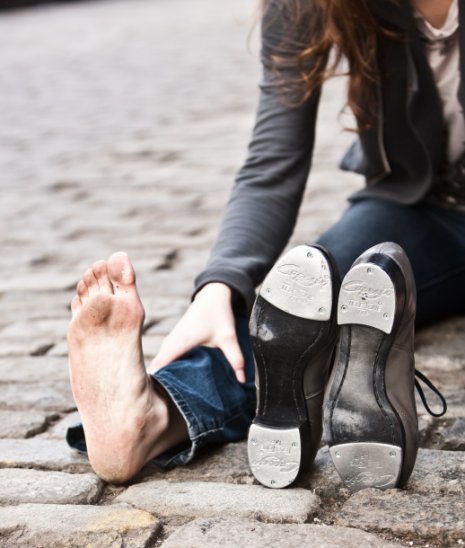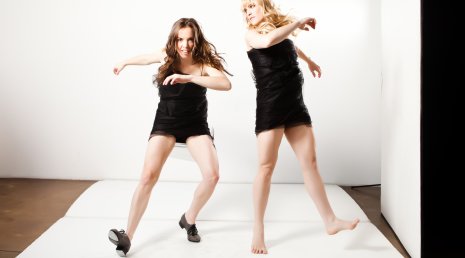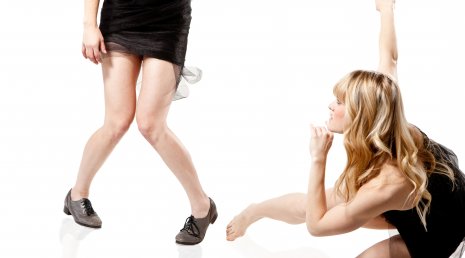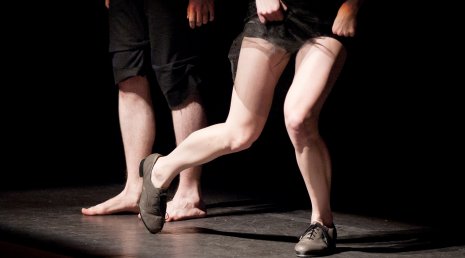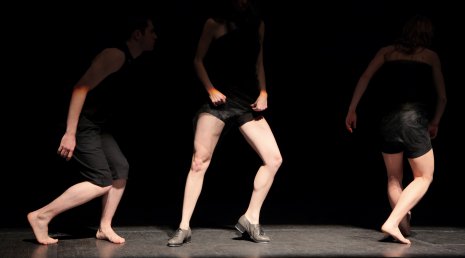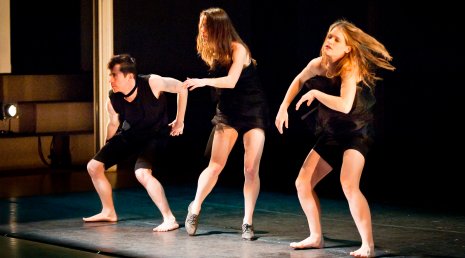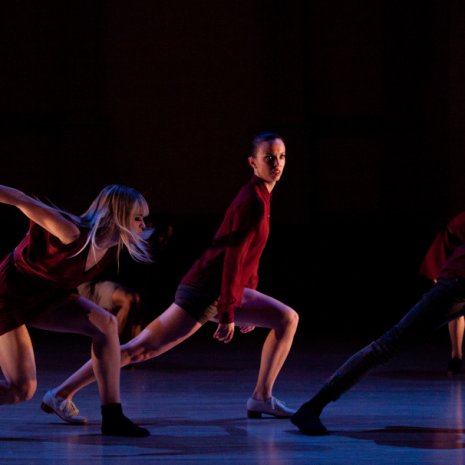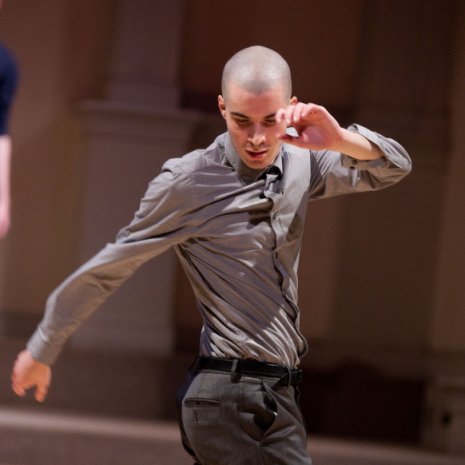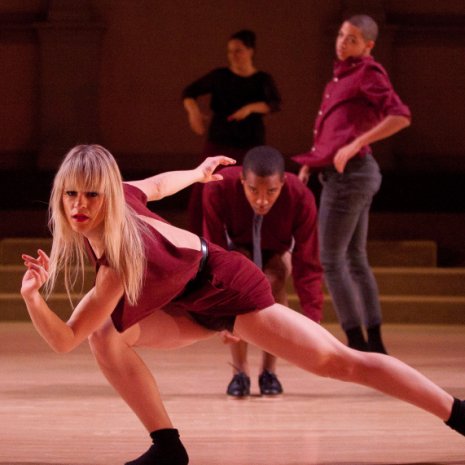Culture maker and Herb Alpert Award winner in Theatre 2011 Marc Bamuthi Joseph* conducted this email interview with Michelle Dorrance during March 2014.
Marc Bamuthi Joseph:
Michelle, I want you to know that I'm THRILLED by the panel's immediate, visceral, and consensus affirmation of your work and possibility. I'm going to kick things off by asking THREE questions to begin that you can answer all at once or one at a time, depending on your bandwidth. I'll take cues of how personal to get from your responses, but my very brief experience with this process is that the work indicates biography in a way that specific episodes within a lifespan cannot.
So...
Who do you represent? This is a purposefully open ended and loaded phrasing of a question that invites you to address the realities of race, U.S. history and gender in the tap form, while also leaning into the question of artistic lineage.
Michelle Dorrance:
Every single time I dance, I represent those who came before me. I represent my mentor, Gene Medler, who not only gave me my tap dance foundation, he taught me how to use it: “Dance to express, not to impress.”
I represent my mom, my dad and my family.
I represent my faith in God, and in the values of giving, sharing, and serving my brothers and sisters in this world.
I represent two cultures that have molded me: Chapel Hill, North Carolina and New York City.
I represent the culture that lives in my soul, tap dance.
I represent my tap ancestors.
I represent my teachers and tap masters.
I feel - like many tap dancers, many hoofers often feel - on a given day, that I must somehow represent the entire history of our art form – a history of racial oppression and injustice but also one of transcendence and transformation, that is more often than not unacknowledged, overlooked or misunderstood. On those days, I must represent master stylists, innovators, stories and truths that are scarcely known to our greater American culture.
Growing up, without being aware of it at the time, I never identified myself as a white woman. I was a tap dancer. Some of my elders even called me a hoofer. I didn’t look up to Ginger Rogers, Ann Miller or Eleanor Powell, not because I didn’t admire them, but because I didn’t relate to them. I related to our masters. I related to one young master and friend, Savion Glover.
Looking back, I remember receiving what I thought was the greatest compliment I’d been given in all my 12 or 13 years when a woman enthusiastically told me I had “black people’s feet” after my performance at a local church. Just a handful of years later, one of our treasured dancer/teachers, Ted Levy, called out a young Kendrick Jones and me to dance alone in front of a class saying, “Isn’t that incredible? They look like two old black men.”
These observations are reflections of how important the embodiment of our history was to us, the children of the tap dance “revival,” and, of course, to our teachers. As a young person, I took what others might find to be racism as the highest form of compliment because I had a deep understanding and respect for the family and the form I was a part of: a black legacy.
I am well aware of tap’s Irish and African roots and the incredible blending of cultures that occurred for this art form to fully come to life but I have always been acutely aware that it was the culture that endured the most continuous oppression and hardship that continued to innovate the form because of the urgency born from those circumstances.
Just like you said in the excerpt I recently watched from “Line Breaks” about hip-hop and the blues: “The culture is born out of hardship. There is an urgency, there is a necessity, there is survival implicit in the art that comes from these conflicts… It had to be made.”
I am not black and I am not oppressed but I represent the urgency that we tap dancers still have for our form. The form is oppressed. The work still has to be made. It is pigeonholed and stereotyped. It is treated like the bastard child of the dance forms. This might explain why, when I am confronted with an audience, I have rarely wondered how they would perceive ME, and instead I have wondered about the preconceptions they have about tap dance, and what I might do to change that.
MBJ:
What ARE you doing to change the perception of tap dance? Who are your allies here in the land of change making? Who/what are you chasing as you journey toward a new place in the form? Who/what are you chasing away?
MD:
I say this all the time but I really believe it: We have to do everything at once. And I say ‘we’ because revolution is never about what just one person can do – we need all the help we can get. We have to keep tap dance, as an art form, present in American culture. How do we do this? We will present tap dance on every different kind of stage, in every different kind of venue. I do not think that tap is best presented ONLY alongside other percussive dance forms like some separatists would have you believe. Tap dance belongs in an art gallery, in a church, on a concert dance stage, in a school, in an arena tour, in a rock club. Every major jazz music festival used to always feature a tap dancer. Ask the original bebop jazz drummers about how it was tap dance that sparked that particular musical innovation and revolution. We will continue to put tap dance back on the Broadway stage with regularity. We need to stop clinging to divisive ideas and devices within different communities and industries; terms like “theatre tap” are our undoing. Black and Blue – the Tony award winning musical review that celebrated black culture in Paris between the first and second World Wars -– featured some of the most respected master stylists and innovators our form has known. Noise/Funk [Bring In ‘Da Noise, Bring In ‘Da Funk] was groundbreaking, won numerous Tony’s and was incredibly theatrical. But neither of those productions subscribed to that divisive nomenclature, “Theatre Tap.” (Nor should they).
We have to demand a respect for the technique and musicality in the form at that level. We must honor the form by integrating it into the study of dance history at every university – not by lumping it and all “other vernacular styles” into a one-hour lecture and NOT by treating a tap dancer in a dance department like a second-class citizen. I will never forget one of my college interviews here in New York (this might have been the turning point when I decided that a dance department was not the place for me). I won’t name the school because they have since started to really embrace tap dancing, but upon mentioning that I wanted to integrate tap into whatever I did there, this person said, “…we don’t do that down and dirty tap dancing like Savion Glover…” – having no idea that he was one of my teachers and inspirations, not to mention a friend.
I think what is most important in our work is to change the way tap dance is perceived. Through performance, through art, through lecture-demonstrations, through academic discourse, and through casual conversation, we have to remind and re-educate this country, and the world, about what tap dance really is at its core: an original “American” art form. (I no longer say indigenous out of respect for Native American culture and history and the great devastations it endured and still endures to this day.)
* Marc Bamuthi Joseph is one of America’s vital voices in performance, arts education, and artistic curation. In the Fall 2007, he appeared on the cover of Smithsonian Magazine after being named one of America’s Top Young Innovators in the Arts and Sciences. He is the artistic director of the 7-part HBO documentary “Russell Simmons presents Brave New Voices” and an inaugural recipient of the United States Artists Rockefeller Fellowship, which annually recognizes 50 of the country’s “greatest living artists.” Bamuthi is the 2011 Alpert Award winner in Theatre and in April 2012, he was one of 21 artists to be named to the inaugural class of Doris Duke Artists. His evening length work ‘red black and GREEN:a blues’ was nominated for a 2013 Bessie Award for “Outstanding Production (of a work stretching the boundaries of a traditional form).” Bamuthi’s next piece in this artistic vein is called /peh-LO-tah/, and is a Balinese style shadow play that examines global economies and sexual identities through the lens of soccer’s World Cup. He is the founding Program Director of the exemplary non-profit Youth Speaks, and is a co-founder of Life is Living, a national series of one-day festivals designed to activate under-resourced parks and affirm peaceful urban life through hip hop arts and focused environmental action. Mr. Joseph is currently completing new works for the Philadelphia Opera and South Coast Repertory Theater while serving as Director of Performing Arts at Yerba Buena Center in San Francisco.


